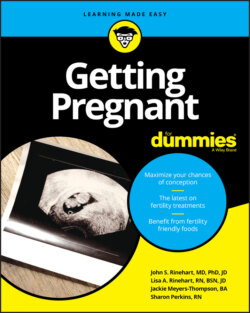Читать книгу Getting Pregnant For Dummies - Sharon Perkins - Страница 67
Inheriting Infertility — Really?
ОглавлениеThe construction of a human is immensely complicated. For proper functioning, all of the various parts need to work together. Any part that does not do its job properly can throw the person out of balance and thus create disease. So normal human functioning means that the systems are in equilibrium and working properly together. Any part not functioning in equilibrium causes the disease. The genetic code determines the basis for the equilibrium; any error in the code can cause the person’s equilibrium to be disturbed, and disease follows. For people having problems conceiving, a question that needs to be answered is whether errors in the genetic code are causing the problem of getting pregnant.
Infertility and sterility are not the same. Infertility implies that pregnancy is not occurring in the normal time frame. Sterility means that the person will never have her own genetic child. So, when a group of people are diagnosed with infertility, there are actually two groups: one group is sterile, and the other group is subfertile and may achieve a pregnancy on their own or may need help with infertility treatments.
There are a number of different types of genetic errors. Sometimes entire chromosomes may be missing or duplicated. There may be deletions of parts of the chromosome or parts that are misplaced or turned around. There can be errors in the letters of the code, thus causing the wrong amino acid to be used. These errors are called single-nucleotide polymorphisms (SNPs). SNPs are the most common form of variation among people. The error is the use of the wrong letter such that an A (adenine) is switched to a T (thymine). Most of these will not alter the functioning of the person, but some can cause severe disease such a sickle cell anemia. There are many types of sickle cell disease depending upon the gene mutation, but one form is caused when the sequence GAG is changed to GTG — one single letter can cause the destructive disease.
The two most common chromosomal problems causing sterility in females are 47 XXX and 45 XO (Turner’s syndrome). The 47 XXX syndrome occurs in 1 in 1,000 female births and causes premature ovarian deficiency. Turner’s syndrome occurs in 1 in 2,000 female births. Turner’s syndrome is a disease caused by an entire chromosome being absent. Turner’s syndrome results when a person has only one sex chromosome — an X chromosome. This person develops as a female with characteristics such as short stature, a web neck, and a low hairline, and about one-third will have heart defects. These people do not make eggs, so they are menopausal from birth and thus are sterile. However, some people with this problem have a mixture of cells with some having only one but some having two X chromosomes. This condition is called mosaicism. Depending upon how many cells are normal, this person may display the signs of a person with Turner’s but actually have some eggs. She may be able to have child, which is rare. Or she may have early normal egg development but run out of eggs very early in life and thus lose the ability to have her own child. If this condition is established early, it is possible to harvest some of the eggs and freeze them for later use.
A second example of a chromosomal cause of sterility occurs in males. Being a male is determined by the Y-chromosome. A gene on the Y-chromosome directs a man to make sperm. The gene is called the sex-determining region (SRY) and is located on the long arm of the Y chromosome. It is passed unmodified from father to son, and thus any abnormality of the gene will be transmitted to a son.
One region of the SRY gene is called the azospermic factor (AZF), and this has three sections termed the a, b, and c regions. Some men with very low sperm counts or with no sperm in the ejaculate have deletions in this region. If a man had a deletion in the “a” region, he will not have sperm and has what is termed Sertoli-only syndrome. That man will not be able to have children that are genetically his. Thus, this type of mutation cannot be inherited. However, if the man has deletions in the “b” or “c” regions, his count may be low or zero but there may be regions of the testes that do make sperm. This man can undergo a testicular biopsy where a very small amount of testicular tissue is removed and tested to see whether sperm are present. If they are, then these can be used in IVF and the man has the possibility for having genetically his own children. If he has a male child, the child will inherit the same deletion as the father, and thus this type of infertility can be inherited.
Males can also have impaired fertility or even be sterile if they have too many Y chromosomes. The person is then XYY and has what is called Klinefelter’s syndrome. Some men with this problem do have sperm in the ejaculate and others have sperm which must be extracted from the testes. Unfortunately, some will have no sperm and are thus sterile.
